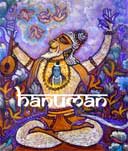 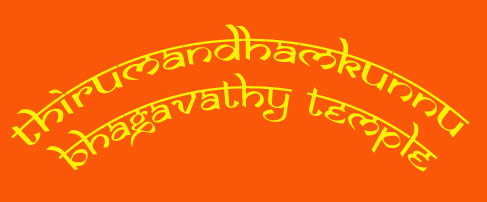  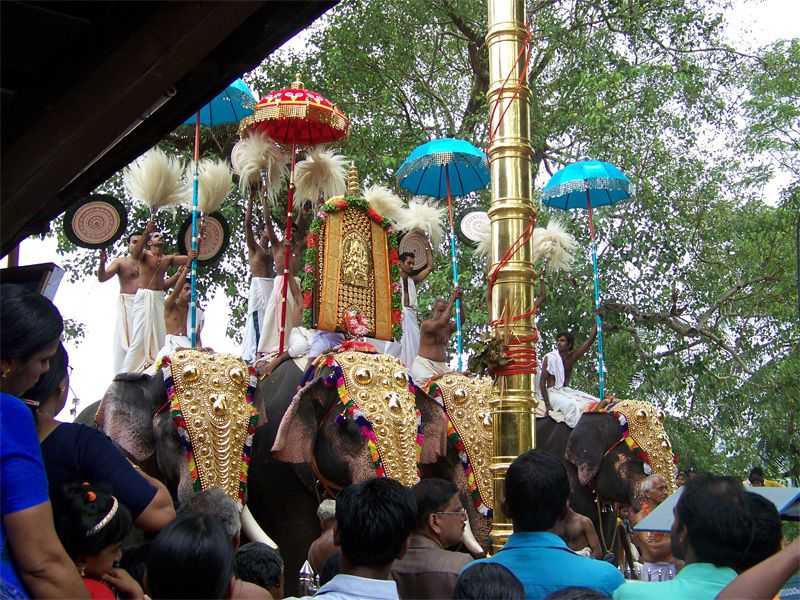 The Temple of Thirumandamkunnu Kerala is a mystic land filled with innumerable temples all of which have strange and amazing legends attached to them. Kerala temple architecture is not ornamental like Tamil Nadu. In fact the temples often look like large houses and have unpretentious gopurams “crown of a temple”, and tiled roofs. Their outstanding feature is the flag staff outside the entrance which is often covered with gold. Though they look very ordinary, from the outside, the fact is that the Kerala temples are repositories of the great psychic power amassed by the great saints who founded them and who did intense tapas on that spot. Temples to the divine mother goddess are most prevalent in Kerala. All of them have great Shakti or divine power in them. Thirumandhamkunnu Bhagavathy temple is one of the most ancient and powerful Mahakshethras (famous temples) of Kerala. The main deity is Bhadrakali and she is very powerful here.  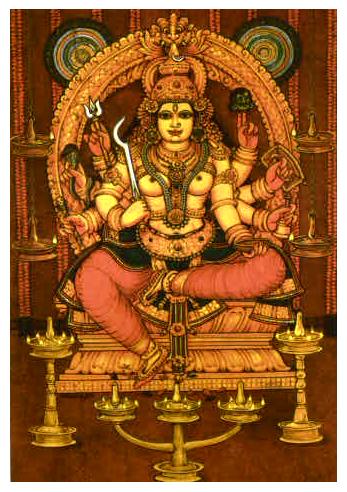  BadriKali My daughter and I decided to visit this temple since we were already in the vicinity of Malappuram district in which the temple is based. We went in the evening when the sun was just dipping down over the horizon. It was the most beautiful time of day. We have to climb up quite a few steps to reach the temple which is situated on a hillock. It has a fabulous view of coconut trees and small hills in the distance. When you come up from the car park the first temple you see is the famous one of Ganesha which is open only on Fridays, Tuesdays and Sundays. Even though the door is closed you can climb up a step and peep through a small aperture which gives you good darshana of the beautiful idol of Ganesha. He is actually famous for removing all obstacles in the way of a girl contracting a good marriage. Every year a special puja used to be conducted on the first Friday of the Malayalam month of Thulam (September/October). If this is done for three consecutive years, the girl was sure to make a very good alliance. However since there is such a demand for this puja, it is now conducted on all Sundays, Tuesdays and Fridays which are considered auspicious for the goddess  We have to go round the Ganesha temple before reaching the main entrance to the Bhadrakali temple. The huge golden flagstaff guards the temple entrance. It is not easy to enter by this doorway since one has to climb over a high step on which we cannot put our foot. This is the entrance which faces the goddess but as we enter, on our right side is the temple to Shiva which has to be worshipped first before entering what is known as the Matrushala or the abode of the Mother. The huge idol of the divine mother is made of “daru” which is actually the jackfruit tree. A number of Bhadrakali temples in Kerala have idols made of daru but this is said to be the best. We can see the idol only by standing to the right or by peeping through a small window in front of her since she is not kept in front of the door but to the left. Apparently she is so powerful that no one can look at her face to face. Even when we look sideways from the right, we can see that she is a most imposing figure about six feet high. She is in a sitting position with the right leg hanging down and the left leg on her right lap. Normally she is covered in a golden mask but when we went this had been removed so we could see her as she was made in black wood. She was pitch black with quite a forbidding look. One has to look carefully to see that she has a crown and ornaments covering her naked breast. She wears bangles and anklets. She is “ashtabhuja” or eight-handed. One hand holds the head of the demon Darika and the others hold various weapons. Behind her we can see the Sapta Matrikas or the seven divine mother- goddesses. Since the light is quite dim we really can’t make out the faces of the Matrikas. By divine grace we had reached at the arati time so we could really enjoy the exhilarating effect of this confrontation with the goddess. As the priest moved the lights slowly over her figure, each part seemed to come to life, lit up by the flickering flames. The child Ganesha is worshipped below the peepul tree on the west side of the temple. We were really happy since we had gone there on Ganesha chaturthi day which is special to Ganesha. 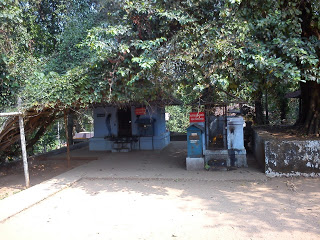  However this linga was the very one which was being worshipped by Parvati who had gone for her ablutions at the time when Shiva gifted the linga to the king. She was quite angry when she found what had happened. Shiva recounted to her the whole story and also told her that she could try and get it back if she so wished. Parvati immediately invoked Bhadrakali and told her to take her host of goblins and get the linga back. Nothing loathe Kali immediately went to the hill but was unable to go near the linga since she was blinded by the brilliance emitted by the linga which was being worshipped by Mandatha. She was forced to retreat. However she started shooting arrows and other weapons at the king and the ascetics who were attending on him. Since they were totally unarmed they plucked some nuts from a tree and threw them back at Kali’s army. Due to Mandhata’s great powers these nuts changed into arrows. This strange fight went on for fifteen days. This incident is still celebrated on the first day of the Malayalam month of Tulam (September/October) by a mock fight called “attanga Yeru”.  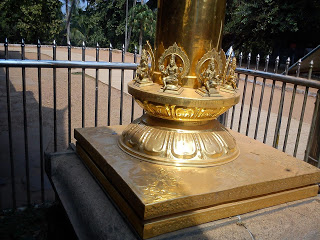 As decreed by Parvati, Kali came accompanied by the Sapta Mathrukas or the seven divine mothers as well as Veerabhadra and Ganesha. They were installed facing north and this place is known as Matrushala or the abode of the mother. Since Shiva is facing east we find two openings to the temple, one to the east and the other to the west. Mandatha stayed in that holy spot for many years and practiced severe penance. When the time came for him to leave this world, he wanted to entrust the temple to someone. Just at that time two Brahmins approached him and promised to look after the temple. He gave them some palm leaves on which he had written instructions as to the method of worshipping the deities of the temple. This is followed to this day. Even now the chief priest of the temple has to be the descendent of one of these Brahmins. The sage-king then retired to the forest close by and was not seen again. Much later an idol of the sage was put in this place and worshipped with all rituals. All the idols in the temple are said to have been sculpted by the master craftsman called Isnika. We were really fascinated by the temple and its surroundings. I was wandering round the place when I accidentally came upon a small copse in which the idol of the sage had been installed. It was almost hidden by the trees and lianas which surrounded it. The whole place looked mysterious and a little frightening. I was quite thrilled to see this and went closer to inspect it. Immediately someone shouted out to me not to go too close. Apparently it was forbidden to do so, especially since the shades of night were already falling. However I thanked the sage in my heart for having shown himself to me. I realised that very few people saw this place since it was quite inconspicuous so it was only his grace that had enabled me to see it. Once again I was made to realise that no one can ever have darshana of a deity unless the deity itself invites you. Hari Aum Sat Tat
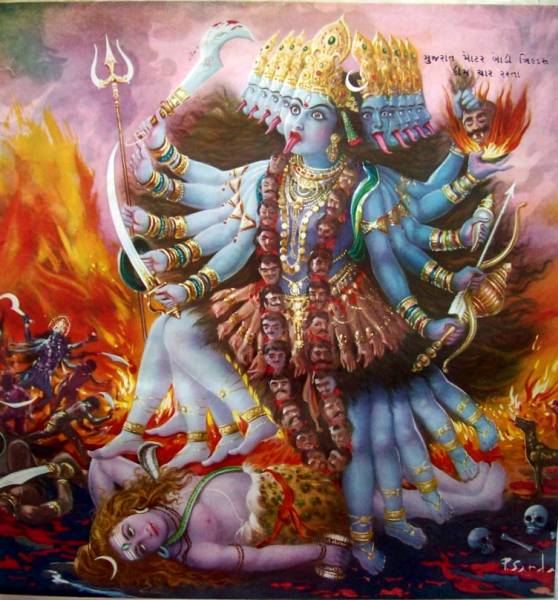
|
